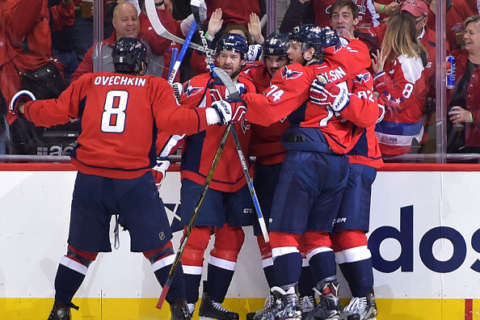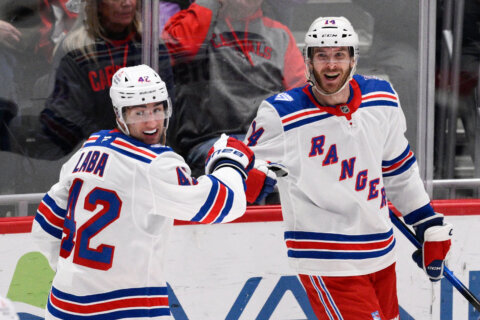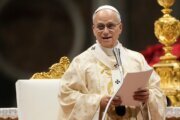Caps opt for versatility over star power at trade deadline originally appeared on NBC Sports Washington
Amidst an Eastern Conference arms race, the Capitals appeared to zig while the rest of the conference zagged.
The Capitals added forwards Marcus Johansson and Johan Larsson, two dependable 200-foot players that should make an impact in all areas of the ice to the forward lines. Compared to what the rest of the conference did, it represented moves to become a more responsible hockey team — especially with the departure of offensively-gifted but defensively-inconsistent Daniel Sprong.
But in total, the Capitals didn’t put all of their chips on the table like other Eastern Conference contenders did. They still have picks in the first three rounds of this summer’s draft and picks in the first two rounds of next year’s draft. They also kept highly regarded young players like Connor McMichael, Hendrix Lapierre and Alex Alexeyev in the organization.
In total, the Capitals added both Johansson and Larsson (with both of their remaining salaries 50% retained) for the cost of Sprong, a 2022 4th, a 2023 3rd and 2023 6th round pick. Their deadline approach wasn’t to splurge on high-powered talent, but rather a calculated maneuvering of players that might help in the playoffs in six weeks.
“I think we were looking for versatile guys, guys that could play against good players,” general manager Brian MacLellan. “We’ve got the Dowd line that can match up against anybody and we’re trying to create another line that can play good two-way hockey against good players.”
In Johansson, the Capitals got a player they’re confident can play at any forward spot in the top nine — because he’s done it before.
Johansson, acquired from Seattle for Sprong as well as 2022 4th and 2023 6th round picks, spent seven seasons in Washington before being traded after the 2016-17 season as a cap casualty and a way to shake up the roster after a playoff loss. Since then, he’s played for five different teams and struggled to stay healthy in the lineup. But he’ll get a fresh start after a six-goal, 23-point campaign with the expansion Kraken.
“I think anywhere in our top nine he can play, both wings, I think he’s a versatile player that has a comfort level with people off the ice and I think on the ice,” MacLellan said. “A lot of games playing with Kuzy, a lot with Nick, knows our power play really well. He can come in and he’s comfortable right away, in my mind.”
A known stellar option at carrying the puck into the zone, both on the power play at five-on-five, Johansson’s numbers have declined since he left Washington. MacLellan indicated he could see time on the first power-play unit too. But now, he’ll join a team familiar with what he can do, where he topped out at 58 points in his final season.
“Since he left, I think he’s developed a lot as a player,” center Nicklas Backstrom said. “I talk to him often, good friend of mine, and it will be fun to see him back here. I think it’s good for us as a team and fun for him to be back here.”
Eight players remain from Johansson’s tenure in Washington, and notably, he was gone when the team won the Stanley Cup in June 2018.
“He’s a really smart player,” winger Tom Wilson said. “He makes the players around him better. He makes smart plays — really good with the puck. He spends a lot of time with the puck. He was kind of a young veteran guy when I was drafted here. A lot of fond memories from those days. He’s a really nice person, a really good person and a good teammate. It’ll be fun.”
To pair with Johansson who will likely find a role in the bottom six, the team added Larsson to help on the fourth line.
“We’ve always liked Larsson, even when he was in Buffalo,” MacLellan said. “He was a real good defensive player, he’s versatile, he can play center, he can play wing, kills penalties, very responsible player, good five-on-five guy. I think there’s multiple uses for him also, and adding center depth if injuries occur is important for us too.”
Larsson is recovering from sports hernia surgery in early February. Per MacLellan, he will need about a week of practice, give or take, to return to the ice.
As MacLellan also added, Larsson can also help out in the faceoff circle should the situation call for it. He has won 49.5% of his career faceoffs, which was another theme of the day: versatility.
“The thing about our lineup is that there are pieces that can move,” coach Peter Laviolette said. “Conor Sheary moves and T.J. Oshie moves and Willy moves up and down the lineup and probably the same for him and once we get things settled and get guys back, we will figure out where the line combinations go.”With Johansson and Larsson in the mix, the Capitals have four full-time centers (Backstrom, Evgeny Kuznetsov, Lars Eller and Nic Dowd) and three (McMichael, Johansson and Larsson) that can play in the middle in a roster/injury pinch. Compared to last year’s team, which played T.J. Oshie and Michael Raffl at center due to a bevy of injuries, they’re much deeper at the center position.
“The parts can move a little bit and you can figure that out once we get everyone back and healthy, so to take an NHL player (Johansson) who has a lot of history of producing offensive and being a two-way player and can play in multiple positions and different roles, I think that strengthens our lineup and could strengthen a line with somebody else,” Laviolette said.
The lineup is certainly deeper than it was 24 hours ago, and in a few ways, more versatile too.
There wasn’t necessarily a sexy move, such as an acquisition of goaltender Marc-Andre Fleury or scoring winger Max Domi, but the deadline consisted of two calculated moves that the Capitals feel will make their team more difficult to play against.
As for if that’ll be enough to compete in a tough conference remains to be seen. But for now, the current iteration of the Capitals will be the one to chase the franchise’s second Stanley Cup when the playoffs begin in 42 days.






